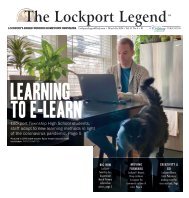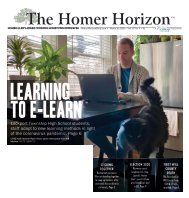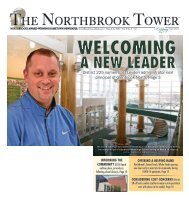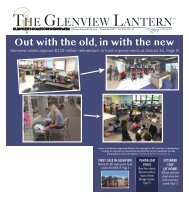GA_071218
You also want an ePaper? Increase the reach of your titles
YUMPU automatically turns print PDFs into web optimized ePapers that Google loves.
32 | July 12, 2018 | The glencoe anchor sports<br />
glencoeanchor.com<br />
Alumni Spotlight<br />
Smith overcomes injuries<br />
to find major success<br />
Michael Wojtychiw<br />
Sports Editor<br />
Going Places<br />
Loyola graduate Boyle makes<br />
most of senior-year opportunity<br />
Michael Wojtychiw<br />
Sports Editor<br />
When moving on to play<br />
college athletics, there will<br />
always be an adjustment<br />
period. Whether that be<br />
because of new training<br />
regimens, stiffer competition,<br />
or just having to deal<br />
with new surroundings,<br />
there will most likely be a<br />
learning curve.<br />
That was the case for<br />
New Trier cross-country<br />
and track and field graduate<br />
Mimi Smith when she<br />
got to Wake Forest University<br />
in the fall of 2015.<br />
For cross-country runners,<br />
some schools, like<br />
New Trier, do more of<br />
low-mileage training and<br />
then focus on strength<br />
training. Some other<br />
schools do longer mileage<br />
training, sometimes 50-60<br />
miles a week, mimicking<br />
the amount of miles a runner<br />
will run in college.<br />
“It was really hard (to<br />
adjust),” Smith said.” I got<br />
injured my freshman cross<br />
country season. Probably a<br />
month and a half in I had a<br />
stress reaction in my shin.<br />
I think that the increased<br />
mileage and then also in<br />
Illinois there are like no<br />
hills. Our training is all<br />
flat. I go to school out at<br />
Wake Forest, so North<br />
Carolina, and it’s really,<br />
really hill-y there.”<br />
A new training regimen<br />
has helped Smith improve<br />
every season she’s been at<br />
Wake Forest, culminating<br />
with a fifth-place finish in<br />
the 10 kilometer race at the<br />
Atlantic Coast Conference<br />
Outdoor Track Championships<br />
in May. That race<br />
was only the second time<br />
New Trier graduate Mimi Smith runs in a race for Wake<br />
Forest University during the 2017-18 school year.<br />
Submitted by Wake Forest Athletics<br />
she had run that distance<br />
in her college career - all<br />
three came during this outdoor<br />
season - and marked<br />
her best finish. Smith<br />
would go on to finish in<br />
19th place at the NCAA<br />
East Preliminaries.<br />
After competing in primarily<br />
the 5,000 kilometer<br />
race during track season,<br />
doubling the distance was<br />
something that took getting<br />
used to.<br />
“I guess my coach and<br />
I decided that I would run<br />
the 10K outdoors because<br />
we had another girl who<br />
she qualified for nationals<br />
on our team in the 10K but<br />
we knew that she was going<br />
to do that at regionals,<br />
which is two weeks after<br />
our outdoor ACC meet,”<br />
Smith said. “The 10K is all<br />
about tactically racing and<br />
just staying even. For the<br />
10K the first 5K shouldn’t<br />
feel that hard. It should<br />
feel hard but you should<br />
by no means feel like you<br />
can’t pick it up. The second<br />
half is really where<br />
you want to negative split<br />
and ramp it up.”<br />
The injury her freshman<br />
year wasn’t the only<br />
one she’s had during her<br />
collegiate career, however.<br />
In December of her<br />
sophomore year, Smith<br />
had a herniated disk in her<br />
lower lumbar and suffered<br />
sciatic pain down her right<br />
leg. However, at the time<br />
she was first feeling the<br />
pain, it was thought to be<br />
hamstring tendonitis, so<br />
she continued to race on<br />
it. It wasn’t until an MRI<br />
at the end of the year that<br />
she found out what was<br />
wrong.<br />
“That honestly was an<br />
injury that was weird because<br />
I could run on it<br />
and I could train on it and<br />
it wasn’t going to hurt it<br />
anymore but it would have<br />
flare ups and just be really,<br />
really painful,” she said.<br />
“It took honestly probably<br />
a year to finally really<br />
reduce the symptoms. To<br />
this day I still feel lingering<br />
effects of it sometimes<br />
but that was kind of honestly<br />
one of the worst injuries<br />
I’ve ever had.”<br />
For the complete story,<br />
please visit GlencoeAnchor.<br />
com.<br />
There’s an old adage<br />
that good things happen to<br />
those who wait. For recent<br />
Loyola Academy graduate<br />
Quinn Boyle, that came<br />
true during his senior year<br />
at the Wilmette school.<br />
After serving as the varsity<br />
football team’s backup<br />
quarterback the last two<br />
seasons, Boyle finally got<br />
his chance to step into<br />
the limelight and lead the<br />
Ramblers to another successful<br />
season.<br />
“Being the backup for<br />
two years in-a-row was<br />
obviously frustrating, but<br />
I did learn a lot,” he said.<br />
“And the success that the<br />
team had senior year, I<br />
don’t think I would have<br />
had as much experience.<br />
“I think that just allowed<br />
me to play with a<br />
chip on my shoulder. Just<br />
in my head thinking about<br />
it —‘this is my time now,<br />
I’ve been waiting for two<br />
years now.’”<br />
Boyle used that anger to<br />
help lead Loyola to another<br />
state title-game appearance<br />
and the second consecutive<br />
second-place finish.<br />
His success as a senior<br />
also allowed him to get the<br />
opportunity to play at the<br />
next level. The Glenview<br />
native will be playing at the<br />
University of St. Thomas in<br />
Minnesota next season.<br />
“I loved the community<br />
there. I loved the atmosphere,<br />
the coaches, fellow<br />
players,” explained<br />
Boyle on why he chose St.<br />
Thomas.<br />
Boyle isn’t sure whether<br />
he’ll have the opportunity<br />
to play next season,<br />
but said that the coaches<br />
have told him that the best<br />
Loyola Academy’s Quinn Boyle stiff-arms a Marist<br />
defender during the state quarterfinals Nov. 11, in<br />
Chicago. 22nd Century Media File Photo<br />
players will play so he just<br />
needs to go out there and<br />
play his game.<br />
Playing for LA and coach<br />
John Holecek has prepared<br />
him for that, he said, because<br />
Loyola runs its program<br />
like a college one.<br />
Thanks to his three years<br />
on the varsity squad, Boyle<br />
had the opportunity to play<br />
in three consecutive state<br />
title games, something<br />
that very few players are<br />
able to accomplish. That’s<br />
something that isn’t lost on<br />
him.<br />
“It starts, No. 1, with our<br />
coaching,” he said. “Not<br />
even in the in-season, also<br />
in the offseason, we have<br />
a great strength coach who<br />
gets us prepared, nutritionwise,<br />
gets us healthy. Great<br />
trainers that do really, really<br />
well. And then obviously<br />
our coaches on the<br />
field who are the smartest<br />
coaches in the state, who<br />
know exactly what they’re<br />
doing.<br />
“And then, just players.<br />
Just living up to the<br />
expectations of getting to<br />
that state championship<br />
is kind of what it is now.<br />
You have an expectation<br />
to not only get there, but<br />
also win. There’s just a<br />
lot of expectations when<br />
you’re a varsity football<br />
player at Loyola Academy.<br />
I think that, combined with<br />
the unreal coaching and<br />
expectation that they have<br />
for us is second to none.<br />
That’s why we’re always<br />
so successful.”<br />
Boyle, who had previously<br />
considered himself<br />
a pocket-passer style quarterback,<br />
became more of<br />
a weapon on the ground,<br />
leading the Ramblers in<br />
rushing on the season with<br />
more than 800 yards and<br />
seven touchdowns.<br />
Due to a couple injuries<br />
throughout the season,<br />
Boyle became more lethal<br />
on the ground, often times<br />
leading Loyola in rushing<br />
and always using his legs<br />
to get him out of trouble.<br />
“The offseason going<br />
into my senior year,<br />
I worked on getting a lot<br />
faster,” he said. “Working<br />
on my running ability.<br />
And I knew if I was able<br />
to add that component to<br />
my game, then I’d be a<br />
lot harder for defenses to<br />
stop.”<br />
For complete story, visit<br />
GlencoeAnchor.com.


















